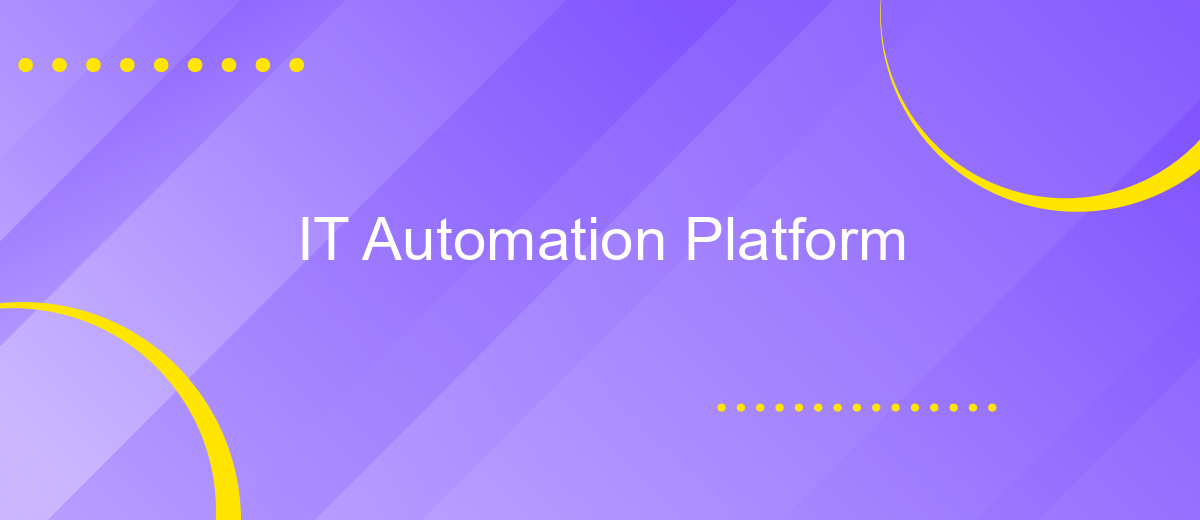IT Automation Platform
In today's fast-paced digital landscape, IT automation platforms have become essential for businesses seeking efficiency, scalability, and reliability. These platforms streamline complex processes, reduce human error, and free up valuable resources, allowing IT teams to focus on strategic initiatives. This article explores the key features, benefits, and real-world applications of IT automation platforms, illustrating how they can transform your organization's operations.
Introduction
In today's fast-paced digital landscape, IT automation platforms have become indispensable for organizations striving to enhance operational efficiency and reduce human error. These platforms are designed to streamline repetitive tasks, manage complex workflows, and ensure consistent performance across various IT environments. By leveraging automation, businesses can focus on strategic initiatives and drive innovation.
- Improved productivity through automation of routine tasks
- Enhanced accuracy and reduced risk of human error
- Scalability to manage growing IT infrastructure
- Cost savings by optimizing resource utilization
- Faster incident response and resolution times
Adopting an IT automation platform enables organizations to stay competitive in a rapidly evolving market. It not only simplifies IT operations but also provides the agility needed to respond to changing business demands. As a result, companies can achieve greater operational resilience and drive continuous improvement in their IT processes.
Key Concepts and Benefits

IT Automation Platforms streamline repetitive tasks, allowing businesses to focus on strategic activities. By integrating various tools and systems, these platforms enhance efficiency and reduce human error. Key concepts include workflow automation, where predefined rules trigger specific actions, and process orchestration, which coordinates multiple automated tasks to achieve a cohesive outcome. These platforms often feature user-friendly interfaces and robust analytics, enabling organizations to monitor and optimize their automated processes continuously.
One significant benefit is the ability to integrate disparate systems seamlessly. For instance, services like ApiX-Drive facilitate the connection between different applications, allowing data to flow smoothly across platforms. This reduces the need for manual data entry and ensures consistency across all business operations. Additionally, IT Automation Platforms can scale with business growth, adapting to increased workloads without compromising performance. Ultimately, these platforms lead to cost savings, improved productivity, and enhanced operational agility.
Architecture and Implementation

The architecture of our IT Automation Platform is designed to be modular, scalable, and highly efficient. It leverages a microservices approach, allowing each component to function independently and communicate through well-defined APIs. This ensures that the platform can be easily updated and extended without disrupting existing services. The core of the platform is built on a robust event-driven framework, which enhances real-time processing and responsiveness.
1. **Microservices Architecture**: Each service operates independently, ensuring fault isolation and ease of updates.
2. **Event-Driven Framework**: Facilitates real-time processing and quick response times.
3. **API-First Design**: Promotes seamless integration with third-party tools and services.
4. **Scalability**: Allows horizontal scaling to handle increased loads efficiently.
5. **Security**: Implements advanced security measures to protect data and operations.
Implementation involves deploying the platform on a cloud-native infrastructure, utilizing containerization technologies such as Docker and orchestration tools like Kubernetes. Continuous integration and continuous deployment (CI/CD) pipelines are established to ensure rapid and reliable updates. Monitoring and logging mechanisms are integrated to provide comprehensive visibility into system performance and to facilitate proactive maintenance.
Use Cases and Applications

IT Automation Platforms are revolutionizing the way businesses manage and streamline their operations. These platforms offer a wide range of applications, from simplifying routine tasks to enhancing complex workflows. By automating repetitive processes, companies can significantly reduce human error, save time, and allocate resources more efficiently.
One of the primary use cases for IT Automation Platforms is in the realm of IT service management. Automated systems can handle tasks such as ticketing, incident response, and system monitoring, ensuring that issues are addressed promptly and effectively. Additionally, these platforms are invaluable in DevOps environments, where they facilitate continuous integration and continuous deployment (CI/CD) pipelines.
- Automated software deployment and updates
- Network configuration and management
- Data backup and disaster recovery
- Security compliance and vulnerability management
- Resource provisioning and scaling in cloud environments
By leveraging IT Automation Platforms, organizations can achieve greater agility and resilience. These tools not only improve operational efficiency but also enable businesses to respond more swiftly to changing market demands and technological advancements. As a result, companies can maintain a competitive edge while ensuring robust and reliable IT infrastructure.
- Automate the work of an online store or landing
- Empower through integration
- Don't spend money on programmers and integrators
- Save time by automating routine tasks
Future Trends and Best Practices
As IT automation platforms continue to evolve, several future trends are emerging that promise to redefine the landscape. One significant trend is the increased use of artificial intelligence and machine learning to enhance automation capabilities. These technologies enable platforms to predict issues, optimize workflows, and make data-driven decisions, resulting in more efficient and resilient systems. Additionally, the integration of low-code or no-code solutions is gaining traction, allowing users with minimal technical expertise to automate complex processes effortlessly.
Best practices in IT automation emphasize the importance of seamless integration between various tools and services. Utilizing platforms like ApiX-Drive can simplify this process by offering a user-friendly interface for connecting different applications and automating data transfer. Regularly updating and maintaining automation scripts, monitoring system performance, and ensuring robust security measures are also crucial. By staying abreast of these trends and adhering to best practices, organizations can maximize the benefits of their IT automation platforms.
FAQ
What is an IT Automation Platform?
How does IT Automation benefit my organization?
What types of tasks can be automated?
Is it difficult to set up IT Automation?
Can IT Automation tools integrate with my existing software?
Apix-Drive is a simple and efficient system connector that will help you automate routine tasks and optimize business processes. You can save time and money, direct these resources to more important purposes. Test ApiX-Drive and make sure that this tool will relieve your employees and after 5 minutes of settings your business will start working faster.


